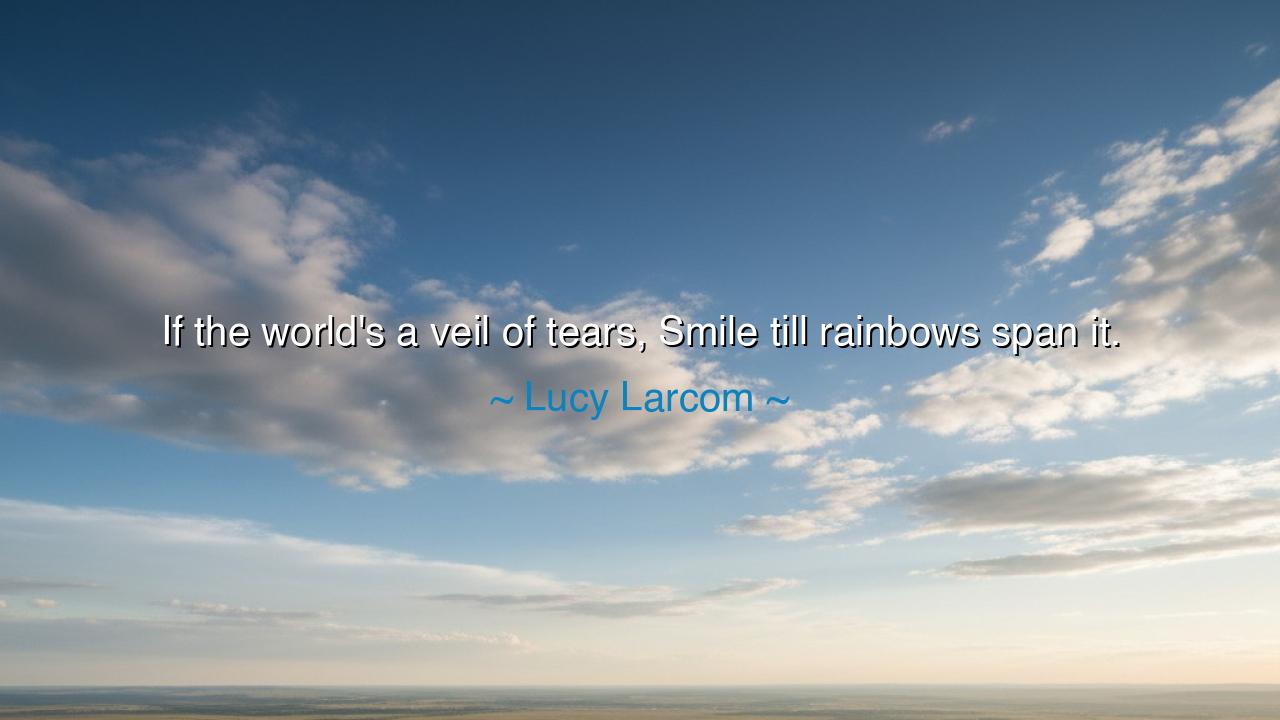
If the world's a veil of tears, Smile till rainbows span it.






The words of Lucy Larcom—“If the world’s a veil of tears, Smile till rainbows span it.”—are at once tender and triumphant. They acknowledge sorrow without denying it, yet they call upon the human spirit to answer grief with courage, to meet tears with hope. The veil of tears is the ancient image of life’s sorrows, the burdens and struggles that weigh upon every mortal. But Larcom’s command is not to collapse beneath it—it is to smile, to lift the face toward light, until even the storms of sorrow are crowned with the glory of a rainbow.
This teaching belongs to the eternal wisdom of resilience. The ancients believed that the soul is tested not by the ease of days but by the hardships that sharpen courage and carve character. To smile in joy is common, but to smile in grief is heroic. The rainbow that follows the storm is the symbol of transformation: suffering transmuted into beauty, despair reborn as hope. Larcom, a poet of the nineteenth century who herself endured hardship, invites us to choose joy as an act of defiance against the weight of sorrow.
History provides us with luminous examples of this truth. Think of Nelson Mandela, imprisoned for twenty-seven years, enduring the darkness of confinement. Yet even in that cell, he carried a smile—calm, steadfast, unbroken. When at last he emerged, it was not with bitterness, but with hope, with the vision of reconciliation that healed a nation. He smiled upon a world of tears, and from his smile arose a rainbow of peace over South Africa. His life proves Larcom’s wisdom: that the act of smiling amid suffering can transform not only the individual but entire nations.
But this quote is not a denial of grief. Larcom does not say, “Do not cry.” She says: smile until rainbows span the tears. The tears must fall; they water the soil of the soul. Yet alongside the sorrow, the smile can shine, refusing to let darkness reign. The rainbow exists only because of both rain and light—it is born from their union. So too with the human heart: only when sorrow meets hope does the full beauty of resilience appear.
The origin of these words lies in Larcom’s own life. Born in poverty, she labored as a mill girl from childhood, working long hours in the factories of Lowell. Yet in that place of hardship, she read, she wrote, and she taught herself to see beauty. Her poems often carried the note of hope that defies despair, for she knew the world’s tears firsthand. Her command to smile is not naïve—it is the wisdom of one who discovered that joy is a choice, a light wrested from darkness.
The lesson for us is this: we cannot choose whether life will bring tears, but we can choose to bring the rainbow. The smile is not a denial of pain but a promise that we will not let pain have the final word. Each smile we give in the midst of difficulty becomes a seed of hope for ourselves and for others. And often, those who need the rainbow most are the ones who cannot see it until another’s smile reveals it to them.
Practically, this means that in times of hardship, we must practice smiling—not as pretense, but as discipline. Begin by noticing the small blessings that pierce through sorrow: a kind word, a morning light, the hand of a friend. Let gratitude shape the lips into a smile. Share that smile freely, even when weary, for in doing so you spread courage. In time, you will see that your own tears, mingled with your hope, form the rainbow that inspires others to endure.
Thus, Lucy Larcom’s words shine as both comfort and command: “If the world’s a veil of tears, Smile till rainbows span it.” The world may always bear sorrow, but within our power lies the choice to meet it with hope. And when enough souls carry this light, the veil of tears is pierced, and the rainbow of human resilience stretches across the sky, declaring that even in grief, beauty is born.






AAdministratorAdministrator
Welcome, honored guests. Please leave a comment, we will respond soon